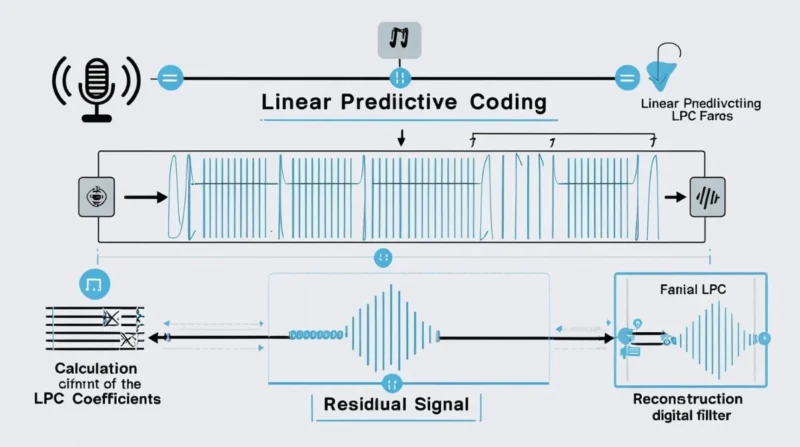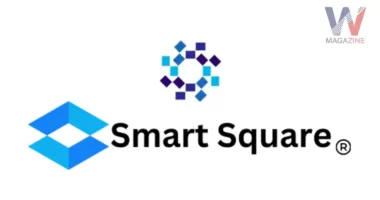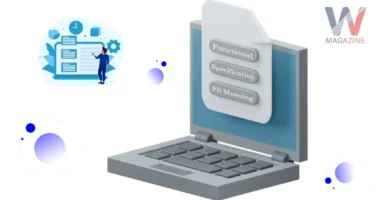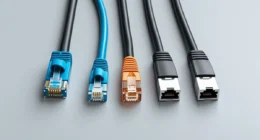Table of Contents
Linear Predictive Coding (LPC) is a popular method used to represent audio signals, especially speech. It compresses speech data efficiently by predicting future audio samples using past data. LPC is widely used in communication systems, mobile phones, speech recognition, and voice compression technologies.
What Is Linear Predictive Coding?
Linear Predictive Coding is a technique that predicts a sound signal using a mathematical model. It assumes that each sound sample in a speech signal can be approximated using a combination of earlier samples. By doing this, it reduces the amount of data needed to represent that sound.
The key idea behind LPC is that our voice has patterns. Instead of sending the full audio waveform, LPC sends the information needed to recreate those patterns. This includes a set of coefficients and a small leftover signal called the residual.
How does LPC work?
LPC works in several steps. Here’s how the process generally looks.
Split the audio into small frames
These are tiny time slices of the voice, usually 20 to 30 milliseconds long.
Analyze each frame
LPC checks how the samples inside each frame relate to each other.
Calculate coefficients
These are numbers that represent how the current sample depends on previous ones.
Find the error (residual)
After using coefficients to predict the sample, there’s always a small difference between the actual and predicted values. That difference is also recorded.
Transmit or store
The system sends or saves the coefficients and the error signal instead of the full audio.
Recreate the speech
On the other end, these values are used to rebuild the original sound with a speech synthesizer or decoder.
Why Use Linear Predictive Coding?
There are several reasons LPC is widely used in audio and speech processing.
- Efficient compression: LPC allows you to represent speech using fewer bits.
- Fast processing: The math involved is relatively simple and can be done in real time.
- Good speech quality: Despite compression, the reconstructed speech remains understandable and clear.
- Ideal for low-bandwidth: Useful for mobile communication and radio, where bandwidth is limited.
Common Uses of LPC
Linear Predictive Coding plays a major role in many areas.
- Speech compression: Used in mobile phones and internet calls to reduce data size while keeping voice clarity.
- Speech synthesis: Helps computers generate human-like speech.
- Voice recognition: Helps systems recognize spoken words by modeling human voice patterns.
- Speaker identification: LPC captures unique vocal characteristics that help in identifying a person.
- Audio analysis: Used by researchers and engineers to study speech and music patterns.
Just like hospitals use coding to efficiently organize and transmit critical health data, speech systems rely on techniques like Linear Predictive Coding to compress and process voice information with precision.
Components of LPC
When using LPC, a few key parts are involved.
LPC Coefficients
These numbers represent how each audio sample is related to its previous samples.
Residual (Error) Signal
This is the part that could not be predicted. It helps in refining the final sound.
Gain
This represents the energy or strength of the signal.
Filter
A mathematical model that uses the coefficients to recreate the sound on the receiving side.
Benefits of Linear Predictive Coding
LPC is popular because it offers several advantages.
- High compression: Greatly reduces the size of voice data.
- Low delay: Works in real time with minimal processing delay.
- Clear speech: Retains good sound quality even with compression.
- Customizable: Can be adjusted for different types of voices and environments.
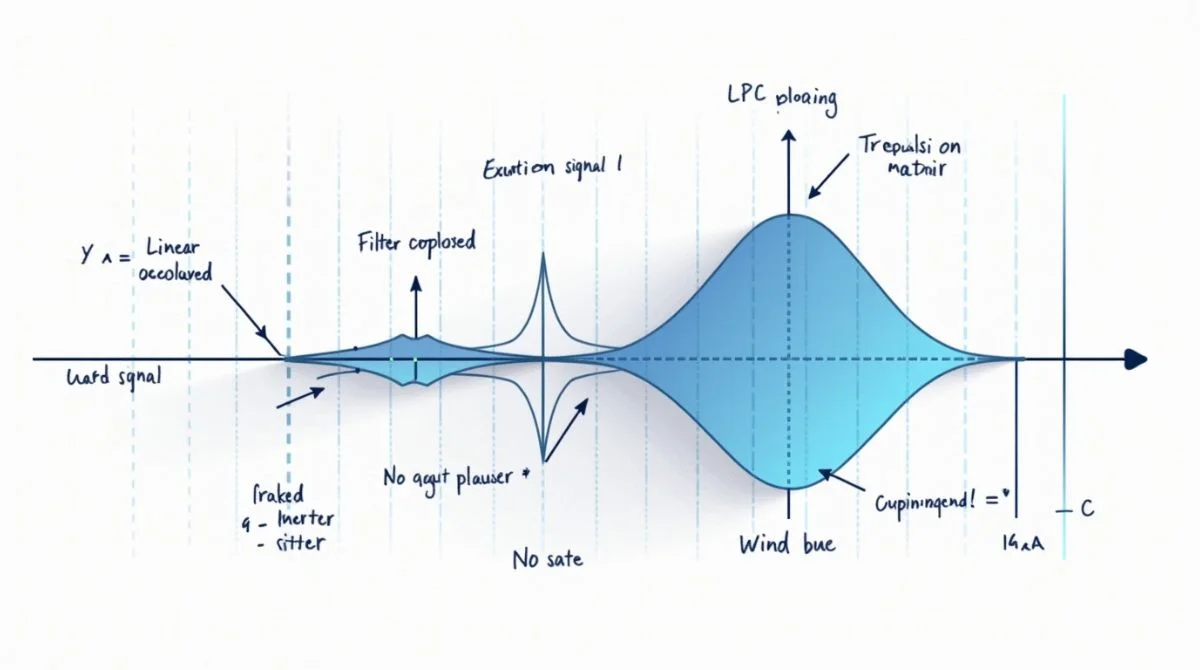
Limitations of LPC
Like any system, LPC also has some downsides.
- Not perfect for all sounds: It works best with speech, not with music or environmental noise.
- Sensitive to noise: Background noise can affect the prediction accuracy.
- Needs careful tuning: Coefficients must be calculated precisely to avoid errors in speech synthesis.
- Unnatural tone in synthesis: Sometimes, the reproduced voice can sound robotic or artificial.
LPC in Real Life
You’ve likely heard LPC in action without realizing it. Most mobile phone calls, voice messages, and even virtual assistants like Siri and Google Assistant use versions of LPC. It helps keep file sizes small and ensures fast transmission over networks.
Many government and defense systems have used LPC-based voice encryption and secure communication tools as well. Its light processing needs make it perfect for low-power devices and portable electronics.
LPC vs Other Compression Methods
| Feature | Linear Predictive Coding | Other Compression Methods |
| Best for | Speech | General audio/video |
| Compression ratio | High | Medium |
| Processing speed | Fast | Slower in some cases |
| Quality | Good for speech | Better for music/sound FX |
| Application | Phones, VoIP, voice apps | Multimedia, music players |
FAQ
Q1. What does LPC stand for?
LPC stands for Linear Predictive Coding. It is a method used to compress speech signals.
Q2. Where is LPC used?
It is used in mobile phones, VoIP, speech recognition, voice recording, and speaker identification systems.
Q3. Can LPC be used for music?
Technically, yes, but it works best for speech. LPC is not ideal for music due to its unpredictable nature and wide frequency range.
Q4. Is LPC real-time?
Yes, LPC processes signals fast enough to be used in real-time systems like phone calls and voice chats.
Q5. Does LPC affect voice quality?
It slightly changes the voice quality, and in some cases, the voice may sound robotic. But it keeps the speech understandable and clear.
Conclusion
Linear Predictive Coding is a smart and efficient way to handle voice data. By predicting audio signals and only transmitting the most important information, LPC allows faster communication with lower data use. It’s perfect for speech-heavy applications where saving space and ensuring clarity are important. LPC continues to evolve and remains a foundation for many modern voice technologies. Whether you’re making a phone call, speaking to a voice assistant, or listening to a digital message, LPC is likely working in the background to keep everything smooth, light, and efficient.
